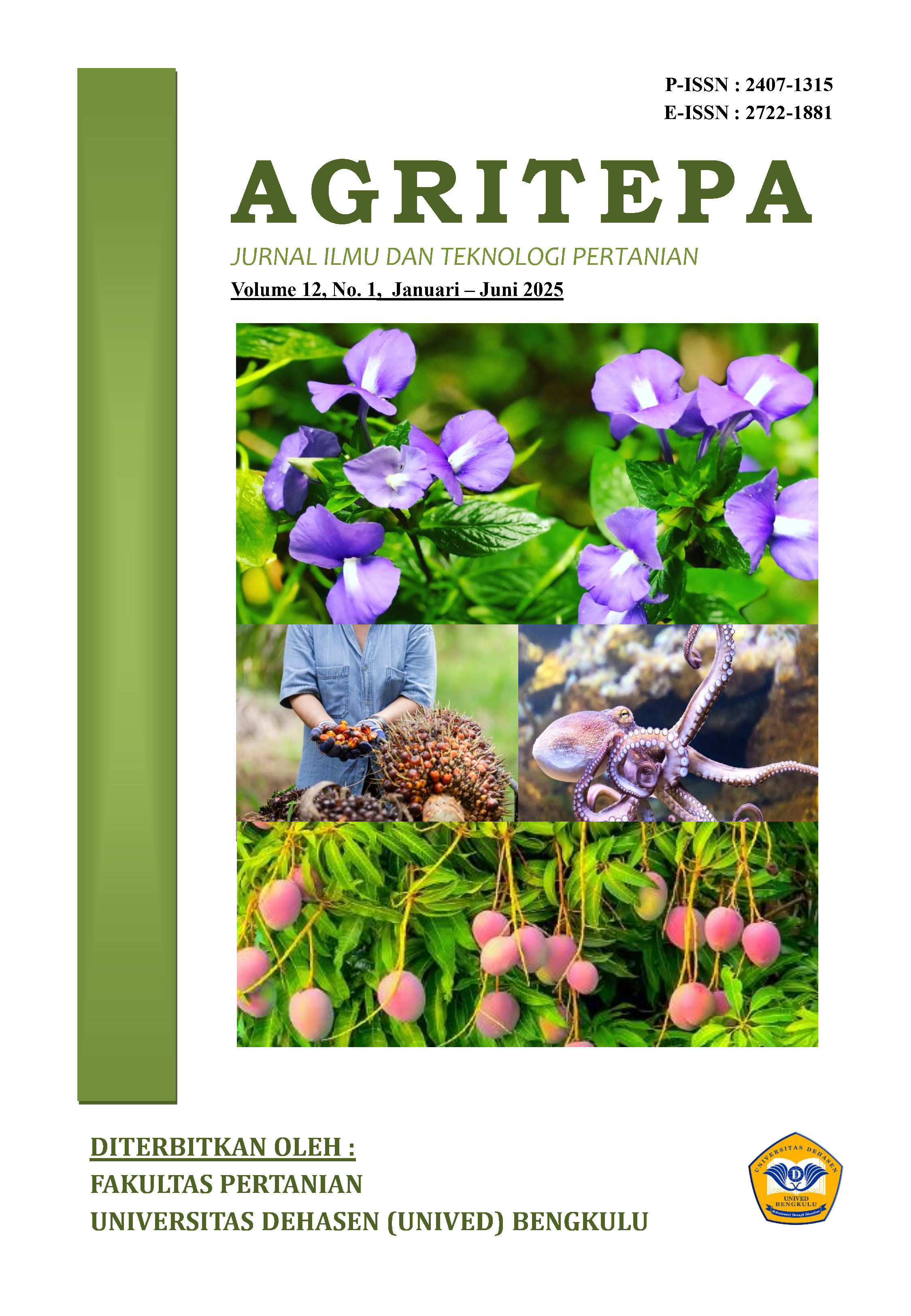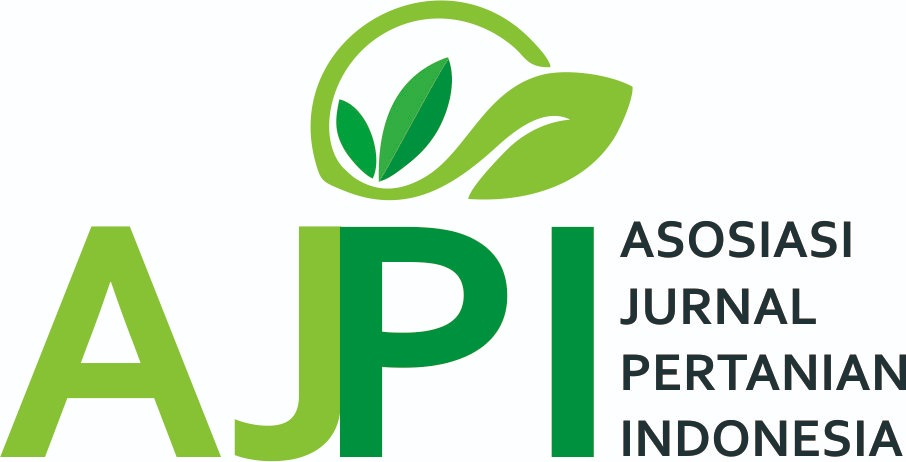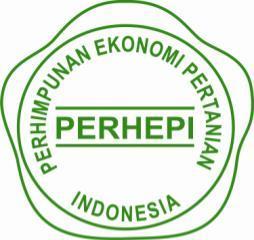Effectiveness Test Of Hot Water Treatment On Mango (Mangifera Indica) Affected By Fruit Fly Stings With Different Temperature And Time Variations
Abstract
Purpose: This study was conducted to highlight the effectiveness of Hot Water Treatment (HWT) as an alternative environmentally friendly method of controlling fruit flies (Bactrocera spp.) on mango (Mangifera indica) fruit, and to determine the optimal combination of temperature and soaking time without damaging the fruit quality. Method: The study used 36 mangoes soaked in hot water at temperatures of 45°C, 50°C, 55°C, and 60°C for 30, 60, and 90 seconds. Evaluation was carried out on the number of larvae that emerged after 7 days post-treatment, as well as observations of the visual condition of the skin and flesh of the fruit. Results: Treatment with a temperature of ≥55°C for 60–90 seconds showed a significant decrease in the number of larvae, from an average of 4.67 larvae (control) to 1 larva. These results also showed no significant visual damage to the fruit at a temperature of 55°C. Conclusion: The combination of temperature of 55°C for 60 seconds is the most optimal treatment, because it is able to kill fruit fly eggs and larvae without causing damage to the skin or flesh of the fruit. Novelty: This study shows that the HWT method can be applied practically and effectively as an alternative post-harvest control at the farmer level, without leaving chemical residues. Conclusion: HWT at a temperature of 55°C for 60 seconds is an optimal and sustainable method for controlling fruit flies without reducing the quality of mango fruit. Article Type: Experimental Research.
Downloads
References
Adak, T., & Kumar, A. (2019). Thermal exposure in hot water treatment of mango: Modelling and optimization. Postharvest Biology and Technology, 149, 186–194. https://doi.org/10.1016/j.postharvbio.2018.12.008
Ahmad, M., & Hussain, S. (2017). Influence of hot water treatment on quality attributes and disease control in mango during storage. Journal of Food Processing and Preservation, 41(4), e13047. https://doi.org/10.1111/jfpp.13047
Ali, A., & Muhammad, M. T. (2019). Efficacy of heat treatments in controlling postharvest diseases of tropical fruits. Journal of Postharvest Technology, 7(2), 32–40. https://jpht.in/article/view/248
Aloui, H., & Khwaldia, K. (2016). Natural antimicrobial edible coatings for microbial safety and food quality enhancement. Comprehensive Reviews in Food Science and Food Safety, 15(6), 1080–1103. https://doi.org/10.1111/1541-4337.12211
Aryani, A., & Hakim, M. L. (2020). Studi kerugian hasil mangga akibat infestasi lalat buah. Jurnal Hortikultura Tropis, 5(2), 77–85.
Badan Pusat Statistik. (2022). Statistik produksi hortikultura 2021. BPS.
Fallik, E., & Porat, R. (2021). Recent advances in postharvest technologies to enhance fruit quality and safety. Trends in Food Science & Technology, 108, 275–281. https://doi.org/10.1016/j.tifs.2020.12.009
Follett, P. A., Neven, L. G., Aloui, H., Khwaldia, K., Aryani, N., Hakim, A., Badan Pusat Statistik, Departemen Pertanian Republik Indonesia, Dinas Pertanian Jawa Timur, Fitriyah, L., Mahendra, D., & Hallman, G. J. (2020). Kajian teknis perlakuan panas dalam sistem pertanian organik. Acta Horticulturae, 5(1), 49–58. https://doi.org/10.1146/annurev-ento-011019-024804
Hallman, G. J. (2019). Hot water treatment for quarantine control of fruit flies. Acta Horticulturae, 1231, 145–152. https://doi.org/10.17660/ActaHortic.2019.1231.19
Heather, N. W., & Hallman, G. J. (2008). Pest management and phytosanitary trade barriers. CABI.
Islam, M. S., Rahman, M. M., & Miah, M. N. (2020). Effect of hot water treatment on shelf life and quality of mango (Mangifera indica L.). Journal of Agriculture and Food Research, 2, 100040. https://doi.org/10.1016/j.jafr.2020.100040
Khalid, M., & Saeed, Q. (2019). Influence of different hot water treatment temperatures on mango fly infestation. International Journal of Agriculture and Biology, 21(3), 487–492. https://doi.org/10.17957/IJAB/15.0963
Kusumaningrum, D., & Wibowo, S. (2023). Pengaruh perlakuan air panas terhadap kualitas buah tropis selama penyimpanan. Agroteknika, 16(1), 35–42. https://doi.org/10.31294/agroteknika.v16i1.20000
Laeliyah, W. N., & Kurniawati, E. (2021). Analisis statistik pada penelitian pertanian: Pendekatan praktis dengan SPSS. Jurnal Agrotek, 10(2), 45–55.
Lin, Y.-Y., & Chen, H. (2019). Genetic diversity and phylogenetic relationships of mango (Mangifera indica L.) in Southeast Asia. Journal of Tropical Crop Science, 6(1), 1–10.
Mohammed, M., & Nazari, M. (2018). Physiological responses of mango fruits to hot water immersion: Effect on fruit quality and storage life. Postharvest Biology and Technology, 138, 108–115. https://doi.org/10.1016/j.postharvbio.2017.12.015
Navarro, S., & Donahaye, E. J. (2016). Innovative environmentally friendly treatments to control insect pests in stored products. Journal of Stored Products Research, 69, 81–92. https://doi.org/10.1016/j.jspr.2016.07.003
Ndlela, T., Magwaza, L. S., & Tesfay, S. Z. (2022). Effectiveness of non-chemical treatments in postharvest disease control and quality maintenance of mango fruit. Food Reviews International, 38(1), 100–118. https://doi.org/10.1080/87559129.2020.1743772
Nurfadilah, S., & Hidayat, R. (2024). Optimalisasi metode HWT dalam pengendalian hama buah: Studi pada beberapa varietas tropis. Jurnal Proteksi Tanaman Tropika, 12(2), 144–153. https://doi.org/10.24843/jptt.2024.v12.i02.p05
Prasetyo, A., & Lestari, D. (2022). Teknologi pengendalian lalat buah berbasis ekologi. Jurnal Inovasi Hortikultura, 14(1), 34–42.
Putri, D. A., & Hartono, S. (2020). Evaluasi kombinasi suhu dan waktu pada perlakuan air panas terhadap ketahanan buah mangga. Jurnal Teknologi Pertanian, 21(2), 89–97. https://doi.org/10.24843/jtp.2020.v21.i02.p02
Roy, D., & Reddy, P. P. (2020). Pesticide residues in fruits and vegetables and their impact on human health. Environmental Science and Pollution Research, 27(14), 16912–16922.
Said, F., & Abdullah, M. (2021). Potensi perlakuan fisik non-kimia untuk pengendalian lalat buah. Jurnal Hortikultura Indonesia, 14(1), 55–63. https://doi.org/10.21082/jhi.v14n1.2021.55-63
Sharma, R. R., & Singh, D. (2017). Postharvest treatments to improve shelf life and quality of fruits and vegetables: A review. Scientia Horticulturae, 230, 25–36. https://doi.org/10.1016/j.scienta.2017.11.039
Singh, Z., & Janes, B. (2021). Postharvest treatment of mangoes: A review. International Journal of Horticultural Science and Technology, 8(3), 15–23.
Suparman. (2020). Dampak serangan lalat buah terhadap produksi mangga di Indonesia. Jurnal Pertanian Tropis, 5(1), 35–42.
Vargas, R. I., & Leblanc, L. (2021). Fruit fly (Tephritidae) impact and control in tropical horticulture. Annual Review of Entomology, 66, 233–250. https://doi.org/10.1146/annurev-ento-041720-075537
Wahyudi, H., & Sari, M. A. (2021). Perbandingan teknik fumigasi dan perlakuan air panas dalam pengendalian hama buah. Jurnal Inovasi Pertanian, 6(2), 22–30.
Yahia, E. M., & Al-Bachir, M. (2018). Postharvest applications of hot water treatments to control fruit pests and diseases. Stewart Postharvest Review, 14(3), 1–10.
Copyright (c) 2025 Mohammad Lukmanul Hakim, Wiharyanti Nur Lailiyah, Suhaili .Suhaili, Adiet Cantyo Pamungkas (Author)

This work is licensed under a Creative Commons Attribution-ShareAlike 4.0 International License.
Author retains the copyright and grants the journal the right of first publication of the work simultaneously licensed under the Creative Commons Attribution-ShareAlike 4.0 License that allows others to share the work with an acknowledgement of the work's authorship and initial publication in this journal













